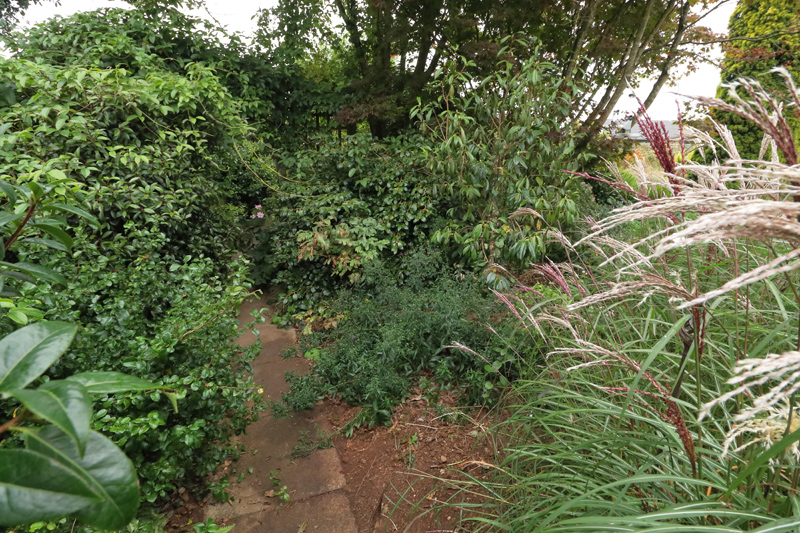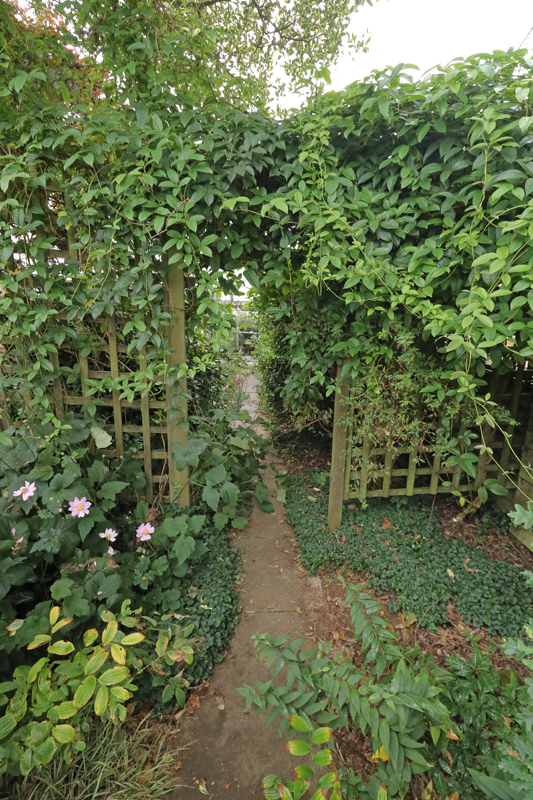It’ll be a familiar tale. A part of the garden that has passed its sell by date, not a lot happening, not visited much and then only to get somewhere else. Chances are it’s dominated by evergreen shrubs that have been getting steadily bigger, casting too much shade, squeezing out the smaller plants.
Tackling it can seem a little daunting, some are choice plants, rather big choice plants which would be a struggle to remove. Could the problems be alleviated by pruning? Well maybe, but how will the plants respond, will they re-grow or die back, and if they re-grow will it be with little or no flower?
This is the problem I have in an area that I will call the side passage. It’s a pathway that starts between two glasshouses then runs close to the garden boundary for seven metres before passing through an archway with trellis to either side, emerging into my shade area.
By no means is it a disaster area but if I don’t get on and do something it could become one. I’ve been taking a long, hard, unsentimental look at it and I’m going to take a little time deciding on the changes I’m going to make.
Stage one is a careful appraisal of what is there now which I’ll do with pictures.

First impressions are not good, a narrow concrete path with the under the bench junk visible in the glasshouse to the left. The Euonymus has been cut back hard because it was blocking the path and the Fuchsia is temporarily filling part of the resultant space. The Daphne part way along flowers almost continuously and is sweetly fragrant but it also encroaches on the path and won’t like being pruned.

Behind the glasshouse is a 1500L water tank which is far from pretty. It is the main reservoir for my rainwater harvesting and the green hose is the pumped supply out that feeds into an underground pipe to the far end of the garden. I could do with a tap here so I can connect a hose to the pumped supply.

The box bush at bottom left is our token piece of topiary and is kept to the same size. At bottom right is a poor, self sown form of Geranium nodosum. To the left is Fuchsia magellanica, hardy enough to form a trunk and grow to around 3m, but regularly losing branches to die-back and at present not in good health. Behind it is Camellia reticulata ‘Mystique’, a superb and rare form which is growing taller every year and risks shading the glasshouse substantially.
The understory includes some ferns and Cardamine trifolia, with masses of mainly hybrid bluebells in spring but bare areas at this time of year. To the left of the path is very shady at ground level; to the right is much sunnier.

The glasshouse to the right has just had a makeover, it’s going to be a display house rather than the propagation house. There is staging right across this end wall now, which will be great for sun loving Pelargoniums.





There’s a blobby, dense Camellia dead centre of the view through the arch. It doesn’t even flower terribly well.

Once through the archway things open up but I still don’t like the tight bush in the centre. I want more of a sense of a woodland glade with an open centre and taller things round the margins.

The archway is a two dimensional affair, basically two trellis panels joined by a strut across the top. The Holboellia is mainly a tangle of stems across the top from which long tentacles hang down. It can’t grow lower down on the trellis because of the camellias growing against the far side.
The ivy up the tree trunk is adding to the overly dense effect.

The focal point at the end of the path is a large tub of masonry paint in a yellow and white tub that is stored under the glasshouse bench.
The inner posts supporting the trellis are sinking and the whole structure needs replacing but how do I do it without destroying the Holboellia, and what do I replace it with?
I have some ideas but nothing is going to happen until after I’ve moved my polytunnel, so I have time to really think it over. It’s often the case that if you look carefully enough at the attributes and shortcomings of an area that solutions suggest themselves. I’m hoping that will be the case here. I plan to tackle it over the winter so expect a follow up blog in the spring sometime.
I can identify with some of the problems that you’ve described, though on a much smaller scale. I’ll be very interested to see how you tackle them.
LikeLike
I’m pegging away at it piecemeal but keeping notes to do a blog about all of it.
LikeLike
Must we all be our own worst critics?
LikeLike
It’s this modern social media thing of airing it for the world’s dubious benefit that I’m less convinced has any merit. I still do it though.
LikeLiked by 1 person
Well . . . my garden is worse than yours!
LikeLiked by 1 person
That was an interesting walk through that part of your garden. I’m looking forward to seeing how you tackle this project. Good luck.
LikeLike
I’ll not be sitting out today, it’s trying hard to rain.
LikeLike
I was excited to find a garden tour in this post. Everything in our little garden can be seen in one glance from the back porch. Good luck with your ideas. I know you’ll come up with winners.
LikeLike
I should do another video before the weather breaks but I doubt it’ll happen.
LikeLiked by 1 person